Seagate Barracuda XT 2TB: SATA 6Gb/s Performance Preview
by Gary Key on October 29, 2009 12:00 AM EST- Posted in
- Storage
AnandTech Small Folder Transfer Results –
In our first storage test, we utilize a 3.82GB test folder and transfer it from our WD VelociRaptor drive to the competing hard drives.

There is only a 2% difference in performance between the two drives on the Intel P55 controller and basically a tie on the Marvell controller. We did not expect anything really different as the average sustained transfer rates between all three drives are very close.
In our second storage test, we utilize the same 3.82GB test folder and transfer it from our test hard drives to the Intel 160GB SSD.
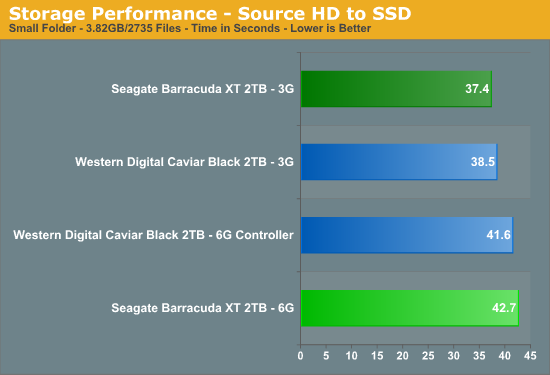
The tables flip here with the Seagate drive performing about 3% faster on the Intel controller than the WD drive. However, Seagate drive is 12% faster in this test on the Intel P55 in 3Gb/s mode than at 6Gb/s mode on the Marvell controller.
In our final small folder test, we utilize the 3.82GB test folder and transfer it from our test SSD back to the competing hard drives.

We finally see the Marvell 9128 chipset making a difference. The Seagate XT drive is 9% faster in 6Gb/s operation than in 3Gb/s mode on the Intel P55. We noticed peak transfer rates of 296MB/s on the Marvell controller compared to 262MB/s on the Intel controller with the Seagate drive. In both cases, the Seagate drive is faster in this test than the Western Digital drive.
AnandTech Large Folder Transfer Results –
In our first storage test, we utilize a 15.2GB test folder and transfer it from our WD VelociRaptor drive to the competing hard drives.
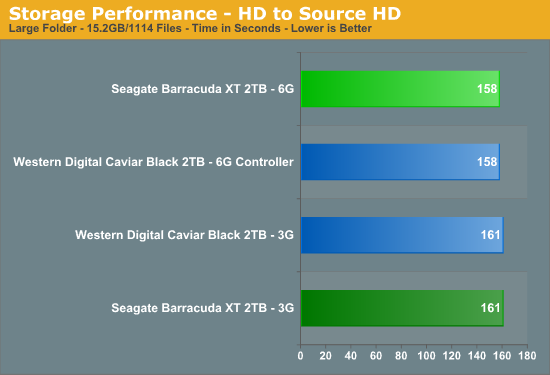
Our two drives perform identically on like controllers, the only difference here is that the Marvell controller is leading Intel in part to the aggressive 1027 driver algorithms that utilize additional system memory for transfer caching.
In our second storage test, we utilize the same 15.2GB test folder and transfer it from our test hard drives to the Intel 160GB SSD.
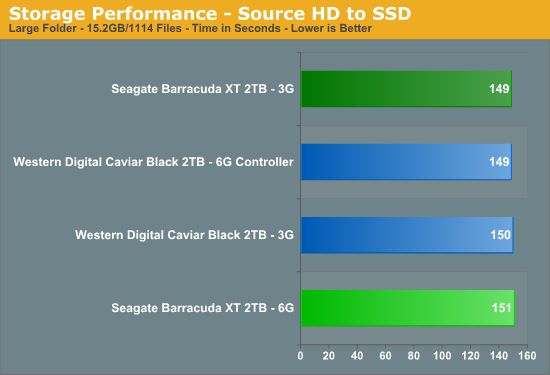
Interestingly enough, the WD drive is faster on the Marvell controller than the Intel. However, the Seagate drive benefits from the Intel controller.
In our final large folder transfer test, we utilize the 15.2GB folder and transfer it from our test SSD back to the competing hard drives.
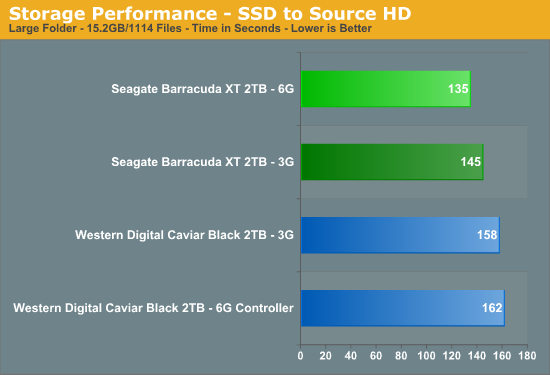
Like our small folder test, we see the benefits of the Marvell Controller in SATA 6Gb/s mode as the Seagate drive is 7% faster than it is in SATA 3Gb/s operation. The WD drive is up to 17% slower in this particular test.
PCMark Vantage x64 Results –
We are showing the total score for the PCMark Vantage disk benchmark as a reference point between the two controllers and drives.
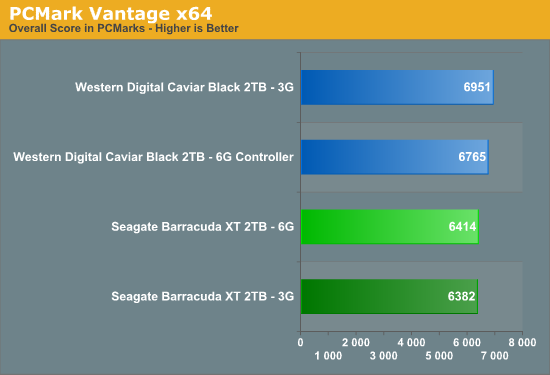
The Seagate XT drive in SATA 6Gb/s mode on the Marvell controller is barely faster than SATA 3Gb/s mode on the Intel controller. The WD drive is just flat out faster in this particular benchmark with the Intel controller being about 3% faster than the Marvell controller.
Quick Thoughts:
That was a letdown in several ways. We never really expected that much out of SATA 6Gb/s technology as our two hard drive samples are just now pushing the boundaries of SATA 1.5Gb/s. Only when we utilized a fast SSD as the source drive to copy files to the Seagate Barracuda XT did we see an advantage in the burst rates available on it and the Marvell 9123 chipset. Even then, the advantage was fleeting as the sustained transfer rates equalized quickly between the two controllers. This test is just the opposite of what a typical user would perform anyway as most would utilize the hard drive for storage purposes and not the SSD.
Even more disturbing was the performance disparity between the Seagate Barracuda XT 2TB and the Western Digital Caviar Black 2TB drive in our limited benchmark test suite. We expected more from the Seagate drive based on its specifications, not the 6Gb/s abilities but platter design and cache setups. Hopefully Seagate can improve performance with firmware changes, if not; the battle is already lost regardless of controller technology.
We just do not see SATA 6Gb/s technology offering any real benefits for spindle-based hard drives on the desktop at this time. Rotational speeds are being kept in check at 7,200rpm with all the performance improvements coming from increased areal densities and cache. We expect SATA 6Gb/s to really come into its own with solid state drives. This will not occur quickly but we expect to see recognizable benefits with controller designs about two generations ahead of where we are currently. By that time, both AMD and Intel will have native 6Gb/s capabilities on their controller hubs.
In the meantime, we see the current implementations of 6Gb/s technology on motherboards as being a marketing checklist feature for the most part. However, since the Marvell 9123 chipset can fall back to SATA 3Gb/s or 1.5Gb/s operational mode it does offer additional SATA ports on the motherboard with performance that is fine for secondary storage devices.










55 Comments
View All Comments
Zak - Thursday, October 29, 2009 - link
Yeah, with port multiplier enclosures data from several drives is transferred over single SATA link. I had port multiplier 4-drive enclosures and with 4 hard drives in RAID0 I was easily maxing out the SATA3Gbps bandwidth.Z.
chrnochime - Thursday, October 29, 2009 - link
300 USD for the Premium Asus board as compared to ~170 for a P7P55D pro version just to have 6GB Sata and USB 3.0? That's a steep price to pay for just these two features.chrnochime - Thursday, October 29, 2009 - link
and it's 6Gb not GB whoops.Affectionate-Bed-980 - Thursday, October 29, 2009 - link
I hate seeing AT falling into the realm of previews. We seem to get more and more of these. Each preview promises followup reviews, but I see less and less follow up reviews or flat out full reviews. Remember when AT reviewed the WD 640gb Blue and the 7200.8s, 7200.10s, all that? Those were nice solid reviews. Now we get previews. Core i7 preview into OCing. No OCing guide today. The only motherboard roundup we got was the 3 or 4 motherboards we had at the i7 launch, while Toms spent 3 or 4 articles doing separate groups of roundups (enthusiasts, midrange, budget X58). I hate THG, and I always respected AT's opinion more, but when we're getting more and more half-assed reviews that are barely finished that DEPEND on follow-ups that aren't always done, then I have a problem.I'd rather see a solid review and be done with it. I'm glad we got a WD 2TB Black, but are you guys going to review that? AT is definitely leading the charge into the SSD world, but as we're doing it, we're forgetting a lot of nice new drives like the WD 2TB Black that I feel deserves a full review. Same with the new Seagate 7200.12s.
Zool - Thursday, October 29, 2009 - link
I think that people dont buy 2TB drives for speed. If u hawe TB-s data that u need to store its the only choice. With those read speeds u could watch fine a 500 Mbit video stream. Actualy with 64bit around for years you could have a 32GB system with for example 24GB ram disk. And ram disk working with intesive read write workload is like 100 times faster than the best ssd. But its actualy rare to have 4+ GB memory still. I think that the storage will be in future in levels like CPU cache. L1 storage smaller for used data and L2 for storage of large data. Or even a ram level (actualy cpu memmory should be divided in levels long ago, buying 32GB of very fast memmory is overkill.U could hawe 2GB realy fast memory and a very cheap 32GB memory which is still much faster than anything else)Everyone who can use brain already know that 6Gb/s sata is just a marketing buzz unless u use a giant raid.
Zak - Thursday, October 29, 2009 - link
Actually, as I went up to 1TB and larger drives I started wishing for more speed too. I use 1.5TB and 2TB disks as backups and mirrors and full backups of terabytes of files take a long time:)Zool - Friday, October 30, 2009 - link
You need to be patient. It wont change any time soon. Even with ssd speeds backup TB-s of data takes hours.Hint: Dont backup that often :)
Maybe there are some programs that monitor only files that were changed and only backup those, not the whole drive. If u want backup that often.
yyrkoon - Thursday, October 29, 2009 - link
Like another user has already mentioned, there is port multiplier technology, which is about the only thing that can use this additional bandwidth _right_now_ . Even then, the drives must be in some form of RAID, and if for performance, you're still going to see access time "doubling".The point here would be I think if people cared that much about performance, they would opt for at minimum an inexpensive SSD that performs decent for a SSD, and completely destroys any mechanical drive. This is not to say that I think your tests are null and void. This *IS* to say that I think that people are going to be more worried about reliability concerning these drives, not so much about performance as long as the performance is close to something reasonable for the technology. I think both drives in this test have demonstrated this level of performance.
Now if you guys really want to impress us mere mortals with numbers, let us see you guys at Anandtech put two iSCSI targets with 32GB of ramdisk each out to a single initiator as a RAID 0 array. Then watch how the drive visible on the initiator smokes all of your tests ;)
Wait until Starwind implements "true" RAID 0 over multiple links the correct way, and it will be even "funner".
Griswold - Thursday, October 29, 2009 - link
"Like another user has already mentioned, there is port multiplier technology, which is about the only thing that can use this additional bandwidth _right_now_ . Even then, the drives must be in some form of RAID, and if for performance, you're still going to see access time "doubling"."No, they dont have to be in any form of RAID. With a PM you can hook them up as individual drives if you want. My point was and still is that with a PM you can saturate a 6Gb/s port that way - but that would be sort of pointless unless you need to hook up more drives than you can attach to your motherboard by using the one-drive-per-port scheme. But if you do need this, this Sata 6Gb/s thing starts to make sense even with spindle drives.
yyrkoon - Thursday, October 29, 2009 - link
If you do not RAID them on a port multiplier, you gain no performance. Read the white papers on SATAIO if you doubt me. As I have known about this technology for more than 5 years now.You can run singles on a port multiplier if you wish, but only one drive will be able to communicate with the system at a time. This is not a bad thing really, because PM will allow you technically up to 15 more drives per port I believe( 16 devices total like SCSI ), but the highest number of drives allowed on current hardware available is only 5 drives per port.
Another downside to port multipliers is that is is all handled in software.Either you use the software provided by the manufacturer, or it is handled in hardware like fake RAID. In the end, it is all software, whether embedded, or not. Also, you require specific chipsets in order for this technology to work at all. In he end, it is not a terrible idea, but SAS puts it to shame. The only downside to SAS is that you require an SAS expander per 8 drives. Since expanders are not cheap, the cost mounts up pretty quickly. Still, it is by far the superior technology.